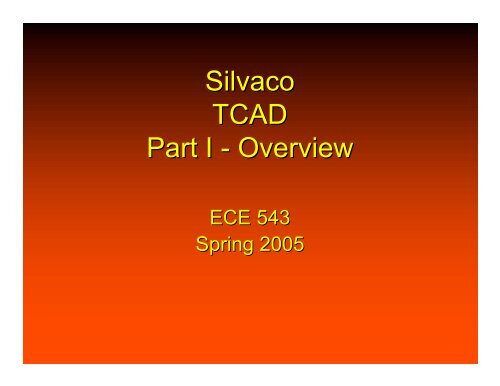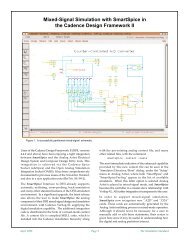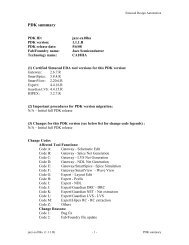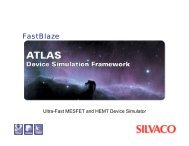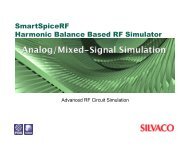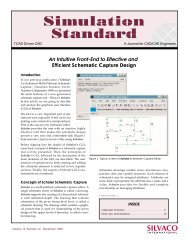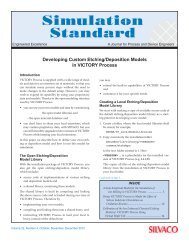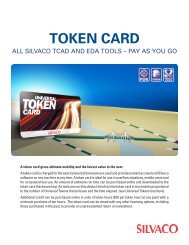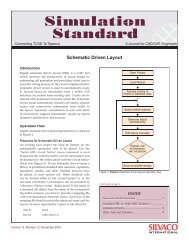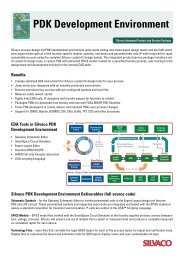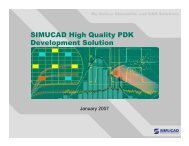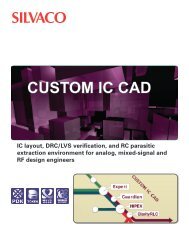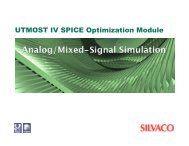Silvaco TCAD Part I - Overview
Silvaco TCAD Part I - Overview
Silvaco TCAD Part I - Overview
Create successful ePaper yourself
Turn your PDF publications into a flip-book with our unique Google optimized e-Paper software.
<strong>Silvaco</strong><br />
<strong>TCAD</strong><br />
<strong>Part</strong> I - <strong>Overview</strong><br />
ECE 543<br />
Spring 2005
• Athena<br />
– 2D Process Simulator<br />
<strong>Silvaco</strong> <strong>TCAD</strong><br />
Simulation Modules<br />
• Atlas<br />
– 1D/2D/3D Device Simulator<br />
– “a modular and extensible framework for one, two and three dimensional semiconductor<br />
device simulation”<br />
• SSuprem3<br />
– 1D Process Simulator<br />
• Mercury<br />
– “Fast” 2D Device Simulator<br />
– “provides general capabilities for numerical, physically-based, two-dimensional simulation<br />
of FETs”<br />
• Mocasim<br />
– “Advanced three-valley Monte Carlo simulator designed to generate the transport<br />
parameters used in the physical device simulators”<br />
TJR, Jr. 2
<strong>Silvaco</strong> <strong>TCAD</strong><br />
General Comments<br />
• Each module is designed to simulate a<br />
specific range of processes<br />
• Learning the syntax of each module is<br />
similar to learning a programming<br />
language – but simple and intuitive (for the<br />
most part)<br />
• Very extensive manuals available for<br />
Athena (438 p.), Atlas (two volumes;316 p. & 332 p. ),<br />
Mercury (168 p.), Mocasim (112 p.), and<br />
Ssuprem3 (218 p.)<br />
TJR, Jr. 3
<strong>Silvaco</strong> – <strong>TCAD</strong><br />
SSUPREM3<br />
• A FAST universal 1D process simulator with simple device<br />
simulation extensions (programming syntax)<br />
• Predicts process doping profiles without the need for<br />
experimental backup***<br />
• Calculates layer thickness for device simulators<br />
• Can also be used to calculate some electrical quantities<br />
• Most important results<br />
– Layer thickness of materials that make up the semiconductor<br />
structure<br />
– Distribution of impurities<br />
• Mainly used to generate impurity profile for transfer into<br />
ATHENA or ATLAS<br />
*** remember GIGO<br />
TJR, Jr. 4
<strong>Silvaco</strong> – <strong>TCAD</strong><br />
SSUPREM3<br />
• Process step capabilities<br />
– Inert ambient drive-in<br />
– Oxidation of silicon, poly-silicon, silicon nitride<br />
– Ion implantation<br />
– Epitaxial growth of silicon<br />
– Low temperature deposition or etching of<br />
various materials<br />
TJR, Jr. 5
<strong>Silvaco</strong> – <strong>TCAD</strong><br />
SSUPREM3<br />
• Can define up to ten different materials<br />
• There are five default materials<br />
– Single crystal silicon<br />
– Polysilicon<br />
– Silicon dioxide<br />
– Silicon nitride<br />
– Aluminum<br />
TJR, Jr. 6
<strong>Silvaco</strong> – <strong>TCAD</strong><br />
SSUPREM3<br />
• Structures can be doped with up to ten<br />
impurities<br />
– Boron<br />
– Phosphorus<br />
– Arsenic<br />
– Antimony<br />
TJR, Jr. 7
<strong>Silvaco</strong> – <strong>TCAD</strong><br />
Athena<br />
• Comprehensive software tool for modeling<br />
semiconductor fabrication processes<br />
• Provides techniques to perform efficient<br />
simulation analysis that substitutes for<br />
costly real world experimentation<br />
• Combines high temperature process<br />
modeling such as impurity diffusion and<br />
oxidation, topography simulation, and<br />
lithography simulation<br />
TJR, Jr. 8
<strong>Silvaco</strong> – <strong>TCAD</strong><br />
Athena Modules<br />
• ATHENA<br />
– This tool performs structure initialization and manipulation, and provides basic<br />
deposition and etch facilities<br />
• SSUPREM4<br />
– This tool is used in the design, analysis, and optimization of silicon<br />
semiconductor structures. It simulates silicon processing steps such as ion<br />
implantation, diffusion and oxidation.<br />
• ELITE<br />
– This tool is a general purpose 2D topography simulator that accurately describes<br />
a wide range of deposition, etch and reflow processes used in modern IC<br />
technologies.<br />
• OPTOLITH<br />
– This tool performs general optical lithography simulation including 2D aerial<br />
imaging, non-planar photoresist exposure, and post exposure bake and<br />
development.<br />
• FLASH<br />
– This tool is used in the design, analysis and optimization of compound<br />
semiconductor structures. It simulates implantation and diffusion in GaAs and<br />
other compound semiconductor materials, including SiGe.<br />
TJR, Jr. 9
<strong>Silvaco</strong> – <strong>TCAD</strong><br />
Athena “Shortlist”<br />
• ATHENA Features and Capabilities<br />
– Bake<br />
– CMP (Chemical Mechanical Polishing)<br />
– Deposition<br />
– Development<br />
– Diffusion<br />
– Epitaxy<br />
– Etch<br />
– Exposure<br />
– Implantation<br />
– Oxidation<br />
– Silicidaion<br />
TJR, Jr. 10
<strong>Silvaco</strong> – <strong>TCAD</strong><br />
Atlas<br />
• ATLAS is a physically-based two and three<br />
dimensional device simulator<br />
• It predicts the electrical behavior of specified<br />
semiconductor structures and provides insight<br />
into the internal physical mechanisms<br />
associated with device operation.<br />
TJR, Jr. 11
<strong>Silvaco</strong> – <strong>TCAD</strong><br />
Atlas<br />
ATLAS provides a comprehensive set<br />
of physical models, including:<br />
• DC, AC small-signal, and full timedependency.<br />
• Drift-diffusion transport models.<br />
• Energy balance and Hydrodynamic<br />
transport models.<br />
• Lattice heating and heatsinks.<br />
• Graded and abrupt heterojunctions.<br />
• Optoelectronic interactions with<br />
general ray tracing.<br />
• Amorphous and polycrystalline<br />
materials.<br />
• General circuit environments.<br />
• Stimulated emission and radiation<br />
• Fermi-Dirac and Boltzmann statistics<br />
• Advanced mobility models.<br />
• Heavy doping effects.<br />
• Full acceptor and donor trap dynamics<br />
• Ohmic, Schottky, and insulating contacts.<br />
• SRH, radiative, Auger, and surface<br />
recombination.<br />
• Impact ionization (local and non-local).<br />
• Floating gates.<br />
• Band-to-band and Fowler-Nordheim<br />
tunneling.<br />
• Hot carrier injection.<br />
• Thermionic emission currents.<br />
TJR, Jr. 12
<strong>Silvaco</strong> – <strong>TCAD</strong><br />
Mercury<br />
Mercury provides a comprehensive set<br />
of physical models, including:<br />
DC, AC small-signal, and full time-dependent analysis<br />
Quantum, Fermi-Dirac, and Boltzmann statistics<br />
Advanced energy balance transport models including Monte<br />
Carlo derived mobility, energy-relaxation, and potential energy<br />
relationships<br />
Abrupt heterojunctions<br />
Heavy doping effects<br />
Ohmic and Schottky contacts<br />
Breakdown effects including impact ionization<br />
Thermionic and tunneling gate currents<br />
General terminal circuit environments<br />
TJR, Jr. 13
<strong>Silvaco</strong> – <strong>TCAD</strong><br />
Mercury Modules<br />
• MERCURY<br />
– framework supplies general capabilities that are accessed by all<br />
the device simulation products.<br />
• FASTBLAZE<br />
– simulates devices fabricated using arbitrary semiconductors (II-<br />
VI, III-V, and IV-IV materials) and heterojunction devices.<br />
• FASTGIGA<br />
– adds the ability to perform non-isothermal calculations that<br />
include the effects of lattice heating and heat sinks.<br />
• FASTMIXEDMODE<br />
– offers circuit simulation capabilities that employ numerical<br />
physically-based devices as well as compact analytical models.<br />
• FASTNOISE<br />
– adds a physically-based noise simulator.<br />
TJR, Jr. 14
<strong>Silvaco</strong><br />
<strong>TCAD</strong><br />
<strong>Part</strong> II - Examples<br />
ECE 543<br />
Spring 2005
<strong>Silvaco</strong> – <strong>TCAD</strong><br />
SSUPREM3<br />
1D process simulator<br />
• Define mesh density in INIT step!!!<br />
• Oxidation Example<br />
– Dry (slow, better quality – for FET gates)<br />
– Wet (fast, lower quality – for masking)<br />
• Diffusion Example<br />
– Pre-deposition step (specify conc. of impurity)<br />
– Drive in step (extract final junction depth)<br />
• Ion Implantation Example<br />
– Dose, energy, tilt<br />
TJR, Jr. 16
<strong>Silvaco</strong> – <strong>TCAD</strong><br />
Athena<br />
1D/2D process simulator<br />
• Define mesh density/grid first!!!<br />
• Oxidation Example<br />
• Diffusion Example<br />
– Pre-deposition step (specify conc. of impurity)<br />
– Drive in step (extract final junction depth)<br />
• Ion Implantation Example<br />
– Dose, energy<br />
• Oxidation with etch and diffusion<br />
TJR, Jr. 17
<strong>Silvaco</strong> – <strong>TCAD</strong><br />
Homework<br />
• Chapter 3<br />
– See table 3.3 for sample<br />
– Problem 3.21 (compare to results of 3.8)<br />
– Problem 3.23 (compare to results of 3.6)<br />
• Chapter 4<br />
– See p.94 and 95 for sample<br />
– Problem 4.20<br />
– Problem 4.21<br />
• Chapter 5<br />
– Redo Example 5.3 with <strong>Silvaco</strong><br />
TJR, Jr. 18
<strong>Silvaco</strong> – <strong>TCAD</strong><br />
Homework<br />
• Hint: Use STATEMENTS section of<br />
manuals for help<br />
– P. 57 in ssuprem3_um.pdf<br />
– P. 251 in athena_users.pdf<br />
• Also look at chapter 2 in this particular manual for a short Athena tutorial<br />
• this is optional, but if you go through this tutorial, you’ll almost have your<br />
homework done!<br />
• Specific info about manuals<br />
– Pcitools.pdf<br />
• Page 49 has details on EXTRACT command for<br />
ssuprem3 (Chapter 2 in this manual)<br />
– TonyPlot has built in help that you might want to<br />
investigate<br />
TJR, Jr. 19


